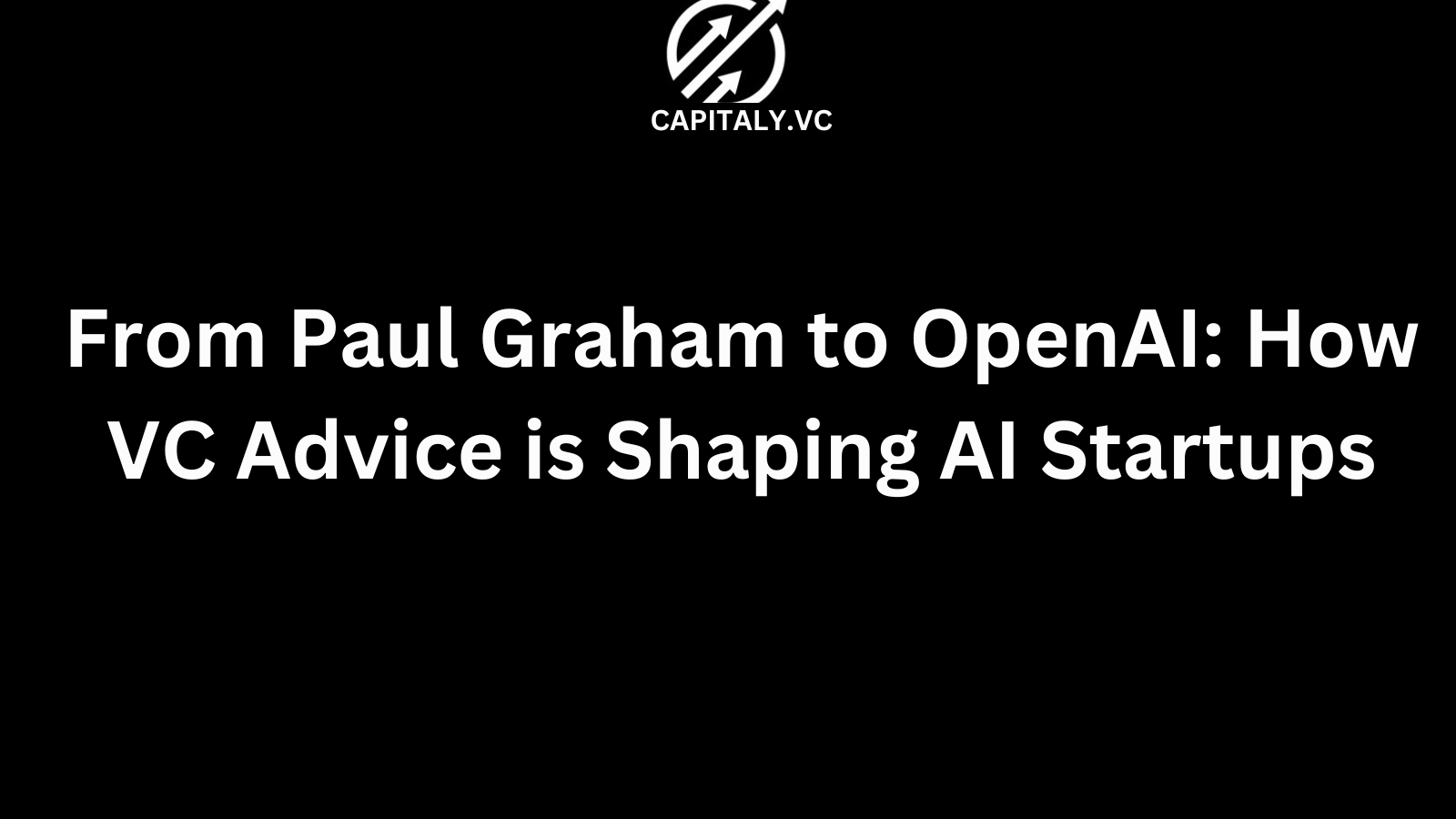From Paul Graham to OpenAI: How VC Advice is Shaping AI Startups
From Paul Graham to OpenAI: How VC Advice is Shaping AI Startups

Why are some AI startups like OpenAI scaling faster than others?
The answer lies partly in the advice they follow — and much of it traces back to Paul Graham and the startup playbook crafted by Y Combinator.
In this post, I’ll break down how early-stage AI startups are shaped by VC thinking — from fundraising strategy to product execution — and why the "Graham gospel" still matters in 2025.

The VC-AI Connection
AI is now the fastest-growing vertical in venture capital.
But throwing money at models doesn’t guarantee success.
Founders who understand the VC mindset win.
They:
- Position their AI like a product, not research
- Solve a pain point, not chase novelty
- Show traction early, even if manually
Read: AI Gets 31% of Venture Funds in Q2/Q3 2024
Paul Graham’s Role in Tech Funding
Paul Graham isn’t just a writer.
He engineered the blueprint that seeded the modern startup.
From his essays like "Startup = Growth" to his YC involvement, Graham’s ideas shape:
- How founders pitch
- How startups launch
- How investors evaluate early traction
See: The Evolution of Y Combinator
Early AI Bets by Y Combinator
YC didn’t wait for GPT-4 to get involved in AI.
Early bets included:
- Stripe (applied AI in fraud)
- Cruise (autonomous vehicles)
- OpenAI (initial nonprofit alignment with safety)
YC backed AI before it was hot.
Startups at the AI Tipping Point
2025 is the tipping point.
LLMs are not just novelties.
They’re:
- Automating customer service
- Replacing backend logic
- Becoming the UI layer of SaaS
Explore: 35 Hot AI Startup Ideas to Ignite Your Entrepreneurial Journey
Lessons from Startup Trenches
What’s working for AI founders right now?
- Ship fast. Show outcomes.
- Don’t raise on hype. Raise on retention.
- Use agents, not teams, to build more.
See: A Step-by-Step Guide to Pitch AI Projects and Raise Private Money
What AI Founders Can Learn from PG
Graham’s greatest hits still apply:
- "Make something people want" → Validate fast with agents
- "Do things that don’t scale" → Manually prompt engineer before automating
- "Ramen profitable" → Stay lean, especially with GPUs eating your margins
AI Funding Trends, 2025
The shift:
- From generalist VCs to AI-native firms
- From pre-product rounds to agent-based metrics
- From vision decks to prompt demos
Read: Skyrocketing AI Startup Valuations
LLM Adoption in Seed Startups
LLMs are no longer experimental.
They’re foundational to:
- Ops (think: internal copilots)
- Sales (lead gen agents)
- Product (user-personalized logic)
More: Startup Fundraising CRM with AI Recommendations
Case Studies: Notion, OpenAI, Others
- Notion added AI as a UX multiplier.
- OpenAI turned models into platforms.
- Rewind.ai went full LLM-first.
Key lesson: AI is not the product. It’s the enabler.
Raising Capital for AI
Here’s what works:
- Traction beats technology
- Micro-use cases close rounds
- Live demos > pitch decks
Guide: How to Attract Investors for AI Projects
The Ethics Mandate
VCs are now asking hard questions:
- Is this AI safe?
- Is it explainable?
- What’s the fallback plan?
See: Navigating Ethical Waters with Investors
Building Communities Around AI
No AI startup scales alone.
Community = early users + feedback + evangelists.
Great AI companies:
- Host Discords
- Launch public playgrounds
- Foster open-source ecosystems
PG’s Warnings and Cautions
Paul Graham warned against:
- Premature scaling
- Obsession with press
- Chasing trends without customers
In AI, this means:
- Don’t hire researchers before PMs
- Don’t spend $500K on infra without use cases
- Don’t pretend to be OpenAI unless you’re OpenAI
Future-Proofing Your AI Startup
Want to stay relevant?
Do this:
- Avoid platform risk
- Build your data moat
- Design for agent interaction, not just UI
Next-Gen VC Advice for AI Innovators
Modern VCs want:
- Proof of execution
- Speed over polish
- Metrics that matter
Founders should:
- Show retention, not vanity metrics
- Demo prompt success rates
- Share agent usage logs
Further Reading: How Predictive AI is Transforming Venture Capital
FAQs
1. Why is Paul Graham relevant to AI startups?
Because his startup principles still guide execution, speed, and product-market fit — which are critical in AI.
2. How did Y Combinator influence early AI?
They funded foundational companies and encouraged fast validation.
3. What do VCs look for in AI startups in 2025?
Working prototypes, clear use cases, and proof that AI adds value.
4. Should I build my own LLM?
Only if it’s your differentiator. Otherwise, use APIs and focus on UX.
5. How do I raise capital for an AI startup?
Show traction, usage metrics, and actual users.
6. How important is ethical AI?
Crucial. Investors now ask about explainability and harm mitigation.
7. What’s the best AI startup model?
Agent-based SaaS — tools that act, not just predict.
8. Do I need a technical cofounder?
Yes. Deep tech = deep understanding.
9. Should I join an accelerator like YC?
If you're early-stage, yes. It brings validation, networks, and fast learning.
10. How can I future-proof my AI company?
Diversify infra, own your data, and design for flexibility.
Conclusion
From Paul Graham’s startup playbook to OpenAI’s ecosystem dominance, VC advice is still shaping the future of AI startups.
The blueprint?
Execute fast.
Raise smart.
Focus on users — not the hype.
If you want to lead the next wave of AI, raise capital the right way:
Subscribe to Capitaly.vc to raise capital at the speed of AI.



.png)